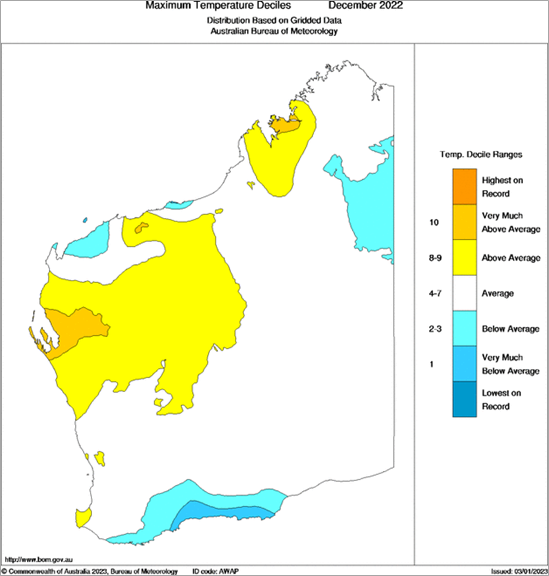The 2022 Grain Season - 2022 Western Australian harvest eclipses record 2021 year
Grain growers in Western Australia are in the final throes of harvesting another record grain crop and the predicted back-to-back record production in WA is now a reality. But, whilst most growers are winding up getting the grain off, there is still a long way to go to move what is on-farm into the bin, particularly in the south of the state.
Issues with moisture, sprouting, storage space and trucking capacity have resulted in around 20 per cent of harvested grain in the Esperance and Albany port zones remaining on-farm and still needing to be emptied out of harvest bags or temporary storage for drying, cleaning and delivery to grain receival sites. This will take time, and the final tonnage will not be known until well into February.
The increase in total tonnes produced in Western Australia in 2022, compared with 2021, has been fueled by a repeat of good growing conditions, a large area of crop planted and a mild finish over the whole of the grain growing regions, without the frost and waterlogging that impacted several regions last season.
For many growers, 2022 was as profitable as 2021, even accounting for the higher input costs. This profit will help fuel further investment in machinery, technology, infrastructure and long-term soil health improvements that were already occurring. Whilst yield will still be determined to a large extent by rainfall and climatic events, this investment will help in contributing to these sorts of production levels in the future.
While final numbers won’t be known until later in February, current estimates indicate wheat is up 1mt from 2021 on a reduced area of 300,00ha, barley is equal on an equal area planted in 2021, canola is up 1mt on an increased area of 500,000ha, mostly in the low rainfall regions, and lupins are equal on a reduced area planted in 2021.
Although not yet over, there were a number of notable highlights in the 2022 season, including wheat exceeding the ten-year average of 9.8mt for the fifth time since 2012, canola production exceeding 4mt for the first time, and never seen before lupin yields of 4t/ha. There were a few negatives that typically come with mild wet growing conditions and a nice finish, such as weed blow-outs, significant barley leaf diseases impacting on yields, and a significant jump in snail numbers in the south. These are some of the things to look forward to tackling in 2023.

Seasonal Outlook
Ian Foster, Department of Primary Industries and Regional Development

Climate Summary
November rain was near-average or wetter for much of the agricultural area, and notably wetter for the South Coast. December saw below average rain in most cropping areas. Conditions remained notably cooler than normal for the South Coast, contributing to quality issues and harvest delays in the region. See Figure 1.
Little rain has occurred in January to date, though widespread lightning strikes have ignited many fires across the cropping region and south-west.
Most climate models show below normal rainfall outlooks for February to April 2023 for the agricultural area of WA. This may be a consequence of the expected decay of the current La Niña event in the Pacific Ocean.
Bureau of Meteorology seasonal outlook summary, issued 5 January 2023:
- Large parts of eastern Australia have close to equal chance of above or below median rainfall for the period February to April.
- Below median rainfall is likely for parts of Western Australia, central Australia and almost all of South Australia, with areas of South Australia and Western Australia having an increased risk of unusually dry conditions.
- February to April maximum temperatures are likely to be warmer than median for almost all of Australia, and very likely to be warmer for much of WA.
- This forecast reflects the status and forecasts for several climate drivers, including La Niña, positive SAM and warm ocean temperatures around northern Australia.
Additional information is available from:
DPIRD: Seasonal Climate Information
BoM: Decile rainfall for November to December 2022
BoM: Rainfall outlook for the next week
BoM: Seasonal Rainfall Outlook

Figure 1. Maximum temperature deciles for September to November 2022. From Bureau of Meteorology.
Geraldton Zone
All areas of the Geraldton port zone had a very good year and there were no weak spots in the north and east where grain yields often fall away. The dry July did quite a bit of damage to early sown crops, although all crops planted during the main season planting window yielded more than ever before. Final grain tonnage will end up being similar to 2021, although for many, it has been a more profitable year, particularly where growers made use of early season grain pricing to lock in the higher prices on offer.
Wheat protein was down on 2021, with many 4t/ha paddock averages. Canola was very good, and lupins were the best ever with 4t/ha paddocks seen for the first time. With a lot of lupins carried over from 2021, and now even more to contend with, growers are weighing up the benefit of lupins on the rotational margins and cost risk versus canola at current pricing to determine which will get the go ahead as a break crop for 2023.
Kwinana Zone
Kwinana North Midlands
The 2022 growing season for the region has shown what the “top end” in production can look like with the new advances in grain growing production systems. Grain yields for wheat, barley and canola were very good and in a lot of cases, the best ever.
Wheat crops were underdone for nitrogen with plenty of grain going to the ASW and new trial grade ASW9 stacks. To counteract this in the future, more growers will be moving to Variable Rate Technology as they change over to new air-seeders. The understanding of which soil types can be pushed to yield more with more fertiliser has come a long way in recent years, and this season has highlighted this even more.
The lack of water damage during the growing season in the region was notable, and helped in contributing to higher whole paddock grain yield averages.
As cereal grain production levels near 20mt per year, demand for some of the traditional specialist grain segments such as noodles for wheat and malt for barley have not increased to the same extent and are now becoming more niche rather than reasonable size market segments.
Kwinana South
Some growers are still harvesting in the south and western areas of the region, caused not so much by delays in harvesting, but by the very high yields making it slow going. All grain crops have been exceptional, and many growers have grown more total tonnes than ever before.
Wheat paddock averages of more than 6t/ha in the western areas are not uncommon. Barley, canola and lupins have also been very good.
The very soft finishes in 2021 and 2022 that to a large extent have driven the very high grain yields, have resulted in a blow-out in weeds, particularly ryegrass coming through late and setting seed. This is also the case right across the state and will cause trouble and extra costs for several years until growers get back on top of numbers.
The region escaped the majority of the rain received further south, and apart from low protein due to grain yield dilution, grain quality has been fairly good.
Kwinana North East
The low rainfall regions of the zone have had a great year all the way out to the north and eastern fringes. More grain has been produced in the northern and north-eastern rim than for many years. Grain protein was mixed with anything off fallow, pasture, lupins or frosted cereals from 2021 making the higher grades.
There is still reasonable subsoil moisture under cereal crops that yielded 2.5t/ha, which will be useful for the 2023 growing season even if the next three months as is predicted end up being warmer and dryer than average.
The mild spring temperatures in spring leading up to harvest, had a big impact on influencing the grain yields achieved, which in some areas north of Merredin and south down to Bruce Rock, were close to the “best ever” for individual growers.
Albany Zone
Albany West
There is still a lot of barley and some wheat to be harvested in the region. Grain yields have been very good and equivalent to 2021 in most cases. Canola crops mostly ended up with higher whole paddock tonnages, higher than in 2021 due to less waterlogging.
Growers in the region have had a dream run over the last few years with less frost and waterlogging than has historically been the case. The shift to earlier sowing has been a game changer for the region and has had a big impact on achieving the large tonnages consistently coming out of the area.
Albany South
There is still quite a bit of harvesting to go with around 30 per cent of the area still to come off close to the coast, and around 20 per cent further to the north of the region. Most growers are now on wheat, finishing up with barley closer to the end of their programs. Grain yields have been exceptional for all crops in the area. There have not been the weather delays to the same extent as there has been further east in the Esperance port zone, although harvest has been slow due to the high yields and logistics of getting the grain to bins. A lot of growers have 1,000 tonnes or more in harvest bags which will be delivered over the next few months.
Albany East (Lakes Region)
Harvest has mostly wound up for the region with growers producing their “best ever” grain yields for the second year in a row. Wheat has averaged 3.5t/ha and barley 3.4t/ha across the region with a surprising amount of barley hitting malt. Wheat protein has been low as it has been across the state, clearly underdone for nitrogen for the yields that were achieved.
The focus in the region has quickly shifted to 2023 and the 5 years beyond that. With growers generally in a much stronger financial position after some good seasons, they are considering what changes to make to production systems and any new technology investments to increase the chances of making the most of “the good years”.
Esperance Zone
A few growers are still harvesting in the Esperance region along the coast although most won’t be “finished” for quite a while. There is an estimated 20 per cent of grain still on-farm in harvest bags and temporary storage that will need delivering to port, grading and cleaning or drying. It has been one of the most difficult harvests for growers in the region due to the rain leading up to and during harvest. The tonnes are there, and it will probably end up similar to the 2021 season which was a record production year. Having said that, it has come at the cost of extra time and handling of logistics to optimise delivery grades.
There has been a lot of sprouted grain, snails and ergot to contend with this year. Some areas have gone from very few snails to very high numbers over the last three years requiring grading. There has also been a lot of spraying for weeds during harvest due to the rain, and ironically there has been plenty of time to get out during harvest and most have already had a single or double knock, which is not normally the case.
Wheat has generally out-yielded the barley, although there has been a reasonable amount of barley hitting malt.